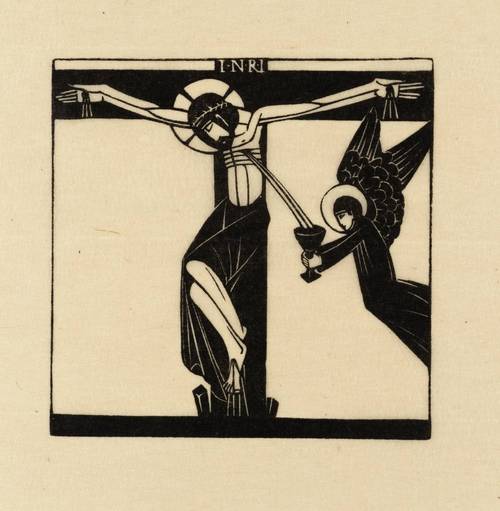Focusing on blood is tough for us modern people—especially sacrificial blood. We don’t really have any category for that.
And yet, if we are to celebrate our redemption in Christ as we did in the previous post on the Evangelical Preaching of the Cross: Redemption, then we must affirm that—in some way— our redemption is “through his blood” (Eph. 1:7). And because evangelicals have always focused on the blood of Jesus, we too will look at Morris’ examination of this category in his Apostolic Preaching of the Cross.
Without blood…

The two “go to” texts for affirming not only the importance of blood, but thought to suggest a “penal” view, are Hebrews 9:22 and Leviticus 17:11. These say that “without the shedding of blood there is no forgiveness” (Heb. 9:22) and that “the life of a creature is in the blood, and I have given it to you to make atonement for yourselves on the altar; it is the blood that makes atonement for one’s life” (Lev. 17:11).
Taken together, Morris, and most penal substitution advocates, see these as suggesting that blood refers to the giving of a life through death, and that this death is the penalty for sins. The result is that sins are forgiven through the offering of death to God, symbolized in the offering of blood.
Blood means death, not life
And yet some say, looking at Lev. 17:11, that blood actually refers to the offering of life itself, not death. If the life is in the blood, then any offering of blood is actually an offering or releasing of life through sacrifice. In this view blood is offered as a defense against death, or to act as a ritual cleanser to wipe away the effects of sin. In this view God—who is the God of life—is offering life through the sacrificial system as a mean of overcome the death entering in through sin.
That the giving of sacrificial blood might indicate the offering of life would be detrimental to the penal substitution view that sees blood as indicating death, and death as the penalty for sin.
Morris therefore begins another word study on blood (see the previous post on the word study method). He finds that outside of sacrificial texts that references to blood overwhelmingly indicate death—usually by violent means.
But what about sacrificial texts that talk about blood? Morris admits that these are more ambiguous. Speaking of Lev. 17:11 he says that the “passage is ambiguous, for the reference to blood could be understood as signifying the presentation of life, or, equally, as indicating the infliction of death. This ambiguities present in nearly all the other passages which connect blood and atonement” (118).
But rather than letting this ambiguity drive Morris further into the sacrificial texts, looking at the rituals themselves and what they might tell us about the meaning of blood, he instead opts to allow the non-sacrificial use to determine the meaning of the sacrificial use (this approach of Morris comes from the good place of allowing scripture to interpret scripture, but is used too quickly before mining the depths of the sacrificial context—interpretive practice should move outward from text, to context (with attentiveness to genre), to canon). By allowing the non-sacrificial text to determine the sacrificial understanding of blood Morris determines that it must indicate violent death, not the offering of life.
Another indication that Morris is not taking the sacrificial context seriously is that he marshals texts of “bloodless atonement” (when atonement is said to happen without the offering of blood) to show that the life is not in the blood, otherwise the life would need to accompany all the atonement passages (119).
I would counter that there are also “sinless atonement” passages—for childbirth, diseases, and nocturnal emissions, and for inanimate objects (Ex. 29:36, 30:10; Lev. 8:14-15; 12:6-8; Lev. 14:10-18; 15: 28-31; 16-15-19). If atonement is substituting one death for another because of sin, then why are there atonement rituals for actions and objects that aren’t sinful?
Morris, however, doesn’t think the problem has to do with his view of atonement (which is only worked out in the next chapter of the book where he argues for a propitiation view). Rather he says the problem is with those who think blood indicates the offering of life.
With this view in hand Morris turns to the New Testament and shows that the blood of Jesus clearly refers to his death.
Only one view of blood?
Returning to our understanding of blood we must ask, “Is only one meaning possible for such a potent symbol?”
I would say no. Why can’t blood refer both to our vital essence (our life-giving force, as it were) and refer to death (when we are deprived of that essence).
Does not the cross of Christ function in exactly this way?
Certainly the cross stands for the death of Jesus and is therefore a horrifying symbol. But it also stands for victory, life, and salvation. This is why people adorn themselves with it. To reduce the symbolism of the cross to a singular meaning is to do injustice the fullness of God’s work for us.
Likewise, blood need not be reduced to a singular meaning of violent death.
Ritual Cleansing
Also, Jacob Milgrom and others have argued that the best sense of the ritual context in Leviticus means that “atonement” refers to a process of cleansing—cleaning the tabernacle and temple of the sin-induced pollutant of death. The entire sacrificial system was a means for maintaining the “cleanness” of Israel, and therefore to keep it holy as God is holy. Unlike the “unclean” Gentiles, God cleanses Israel and draws near to her in and through the temple.
Sacrificial blood, therefore, has to do with cleansing in some fashion, the means by which God keeps his people clean from the effects of sin and death.
Of course I, like Morris, are jumping ahead with an understanding of atonement and interpreting “blood” through that meaning without doing the hard work of examining the evidence (we’ll do that next time I hope).
New Testament Cleansing
But this view that blood cleanses or purifies us finds its way into the New Testament, though often overlooked by supporters of penal substitution (added to all these is Jesus’ ministry of cleansing people in various ways.
“How much more, then, will the blood of Christ, who through the eternal Spirit offered himself unblemished to God, cleanse our consciences from acts that lead to death, so that we may serve the living God!” (Heb. 9:14)
“In fact, the law requires that nearly everything be cleansed with blood, and without the shedding of blood there is no forgiveness.” (Heb. 9:22)
It is interesting how often those claiming that sacrificial blood indicates death fail to quote the first part of Heb. 9:22!
“Otherwise, would they not have stopped being offered? For the worshipers would have been cleansed once for all, and would no longer have felt guilty for their sins.” (Hebrews 10:2)
“…and the blood of Jesus his Son cleanses us from all sin.” (1 John 1:7)
The idea that cleansing is necessarily connected to punishment is not demanded by these texts. The idea of substitution isn’t clearly connect view either.
“Brought near by his blood”
A last passage to consider—though to do it justice would take several other posts—is Eph. 2:11-22, especially verse 13—a verse that Morris hardly mentions.
Paul says, “But now in Christ Jesus you who once were far off have been brought near by the blood of Christ” (v. 13). Paul is speaking here of the separation between Jews and Gentiles caused by the law. But now, through the blood of Christ, all people can come near to God, not just the Jews. Through Jesus all people can now enter God’s presence for “through him both of us have access in one Spirit to the Father” (v. 17). Indeed, in Jesus Jews and Gentiles together are being built up into a structure that “is joined together and rises to become a holy temple in the Lord. And in him you too are being built together to become a dwelling in which God lives by his Spirit” (vv. 21-22).
If the tabernacle and temple were cleansed by blood in order to maintain Israel’s access to God, then, now in Christ—through his blood—all people are cleansed and have access to God’s presence through the Spirit. While the word cleanses/purifies is not used in this passage, an understanding of the sacrificial system as maintaining “cleanliness” in distinction from the Gentiles (who are be definition “unclean), clearly suggests that Paul has cleansing in mind as what allows for access to God.
Jews and Gentiles are cleansed by the blood of Jesus, and can now fellowship with one another in the presence of God.
Now that is good news for all of us!
It is too bad that Morris’ word study approach could not express the riches of reconciliation accomplished through the blood of Jesus. He instead focuses only on blood as death—an unfortunate tendency still followed by the current evangelical preaching of the cross.
(For a mini-course expanding your understanding why Jesus died, see The 3 Forgotten Reasons for Jesus’ Death — it’s a distilled version of my lectures at Northern Seminary on the atonement.)

